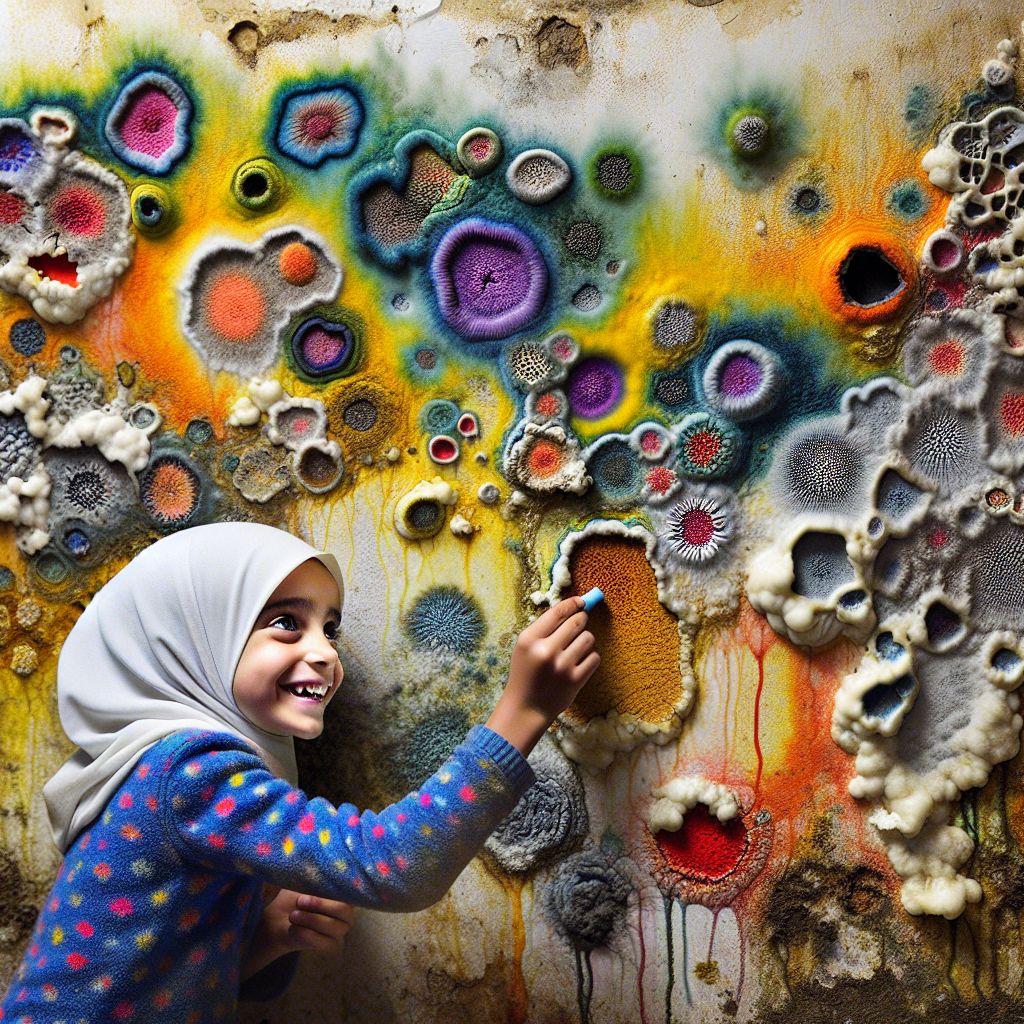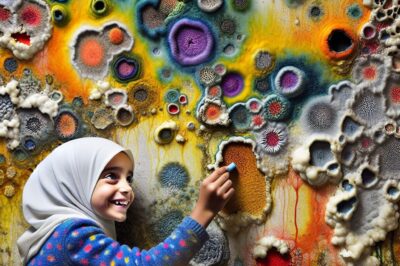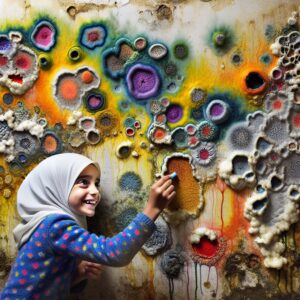-
Mold, a common fungus that flourishes in wet environments, can have a variety of detrimental effects on the health of children.
-
Exposure to mold may result in respiratory problems, allergies, and asthma, all of which can affect a child’s overall health and happiness.
-
The environment in which a child grows up plays a crucial role in their creative development, and having a healthy home is crucial for nurturing imagination and creativity.
-
Physical health is closely tied to cognitive function and creativity, and chronic health problems can interfere with a child’s ability to think and create.
-
Parents and caregivers can take steps to prevent mold growth and safeguard their children’s health and creative potential.

Getting to Know Mold and Its Commonness in Homes
What is Mold, Exactly?
Picture tiny intruders that can enter your home without being seen, establish a home, and start causing all sorts of problems. That’s mold – a type of fungus that grows from tiny airborne spores. It’s not just unattractive; it can secretly undermine your child’s health and, as a result, their creativity.
Typical Indoor Molds
When we discuss mold in homes, we’re usually talking about a few common culprits. There’s the infamous black mold, scientifically named Stachybotrys chartarum, which is often spoken about with a sense of dread. But we also have Penicillium, Aspergillus, and Cladosporium. These molds may appear as spots on walls, hide in damp basements, or lurk in bathrooms with persistent moisture.
The Perfect Environment for Mold
Mold is a big fan of dampness. It doesn’t matter if it’s a leaky faucet, a flood, or just high humidity levels, all of these conditions can create a breeding ground for mold spores. In addition, lack of proper ventilation, warm temperatures, and organic materials such as wood or paper can turn your home into a haven for mold. This is why I always advise parents to monitor these conditions in their homes to safeguard both their property and their kids.
How Mold Exposure Can Make Your Child Sick
Breathing Problems Caused by Mold
Mold isn’t just unsightly. When children inhale mold spores, their immune systems can respond, causing coughing, wheezing, and other breathing problems. These symptoms can worsen over time, leading to chronic respiratory conditions that no parent wants for their child.
How Mold Impacts Allergies and Asthma
Not only that, but mold exposure can also be the catalyst for allergies or even asthma in children. These conditions can drastically change a child’s quality of life, resulting in missed school days, less time for play, and more trips to doctors like me. It’s sad to witness, especially when it’s something that could have been avoided.
How Children Respond Differently to Mold
It’s important to note that children will not all have the same reactions to mold. Some may only have minor symptoms, while others may have much more severe reactions. This often depends on how sensitive the child’s immune system is, their general health, and how long they have been exposed to the mold. As a parent or caregiver, it’s important to be aware of these differences and respond appropriately.
As a practicing family doctor, I have witnessed how mold can influence a child’s life. When I moved from Texas to Pennsylvania I suddenly saw more cases of asthma in a week than I might see in half a year in Texas. The main culprit most of the time is mold.
The Impact of Stress and Anxiety on Children with Mold Illnesses
When children are constantly battling health issues like those caused by mold, it’s not just their physical health that’s affected. The stress and anxiety that come with constant coughing, sneezing, and other uncomfortable symptoms can be a heavy burden for them to bear. This emotional strain can drain their energy and happiness, leaving them with less capacity for creativity and discovery.
Linking Joy and Creativity in Kids
In the realm of child development, joy and creativity are closely linked. A child who is happy is more likely to play, and play is the bedrock of creativity. Play gives children the chance to experiment, solve problems, and express themselves in a unique way. When their health is affected by something such as mold, their natural desire to play and create can be suppressed.
It isn’t only about the physical symptoms; it’s about how those symptoms affect the children. If they’re sick, they’re less likely to be happy. And if they’re not happy, their creative spark – that little something that allows them to imagine new worlds and possibilities – can begin to fade.
The Impact of a Positive Space on a Child’s Creativity
A positive, healthy space can be likened to fertile ground for a child’s creativity. When children feel secure and comfortable in their environment, they’re more likely to let their creativity fly. They’ll construct fortresses out of sofa cushions, transform cardboard boxes into rocket ships, and doodle drawings that contain narratives only they can narrate. But if mold infiltrates their space, it can turn their safe sanctuary into a place that impairs their health and their capacity to dream and create.
The Connection Between Joy and Artistic Expression
Studies have found that children who are generally happier are also more creative. These are the kids who eagerly participate in art projects, who invent complex stories, and who are not afraid to think differently. When children are burdened by health problems, such as those caused by mold, their natural tendency to be happy and creative can be hindered. That’s why it’s so important to tackle these environmental issues.
Psychological Comfort and the Liberty to Innovate
For creativity to thrive, the idea of psychological comfort is crucial. Kids need to feel safe in their surroundings to take the risks associated with creative expression. If they’re concerned about their health or the air they’re breathing, that feeling of safety is threatened. As parents and caregivers, we’re responsible for making sure our homes are not just physically safe, but also emotionally nurturing environments where kids can relax and be their most innovative selves.
Hence, dealing with any mold problems in the house is not just about health, but also about fostering the creative spirits of our kids.
The Effect of Health on a Child’s Creative Capabilities
When we discuss creativity, we’re essentially discussing a child’s ability to use their brain in ways that are unique, adaptable, and imaginative. However, for that to happen, their brains need to be operating at full capacity. Health problems, including those caused by mold, can interfere with this sensitive process.
Illnesses caused by mold can result in symptoms such as headaches and fatigue, making it difficult for a child to concentrate or think lucidly. These are not simply minor annoyances; they are hindrances to the cognitive processes that support creativity.
Primarily, a child’s brain is still in the process of developing. Anything that affects their health can potentially affect their brain development, which in turn can influence their creativity.
The Connection Between Physical Health and Cognitive Abilities
Believe it or not, physical health and cognitive abilities are closely linked. A child who is in good physical health is more likely to have the energy and mental sharpness required for creative thinking. Here’s how it works:
-
Energy: Being in good health gives children more energy to engage in creative activities.
-
Concentration: Without physical ailments to distract them, children can better focus on creative tasks.
-
Mood: A healthy child is generally in a better mood, which can encourage creativity.
On the other hand, when a child is dealing with the effects of exposure to mold, their energy levels, ability to concentrate, and overall mood can all be negatively affected, which can limit their creative potential.
Health and Creativity: How They Interact in the Brain-Body Connection
The brain and body are not isolated; they function in unison. A fit body fosters a fit mind, and a fit mind can produce astonishing creativity. However, when children are confronted with ongoing health problems such as those related to mold exposure, this unison can be disrupted, resulting in a reduction in creative output.
Long-Term Health Problems and Effects on Cognitive Growth
Long-term health problems can have a significant effect on a child’s cognitive growth. The brain is an organ just like any other, and when a child’s overall health is compromised, brain growth can be affected too. This can mean delays in the growth of certain cognitive skills, including those related to creativity. Addressing mold issues promptly is therefore not just about alleviating immediate symptoms—it’s about protecting a child’s future potential.
Therefore, parents and caregivers need to stay alert for signs of mold and quickly take steps to deal with it.
The Importance of Mold Removal for Your Child’s Creativity
As we have learned, mold is more than just a household inconvenience—it is a risk to a child’s health and creativity. Knowing the dangers of mold and how to prevent and remove it, we can help our children have the best possible opportunity to fully develop their creative skills.
So, dealing with mold in the house is more than just about being clean and looking good. It’s about creating a place where kids can develop, learn, and be creative without being held back by health problems.
Active Steps to Halt Mold Development
Stopping mold from growing is essential to keeping your child’s home environment healthy. Here’s what you can do:
-
Maintain humidity levels in your home below 50% using dehumidifiers or air conditioners.
-
Ensure good ventilation, especially in areas like bathrooms and kitchens where moisture is common.
-
Repair leaks and any water damage quickly to prevent mold from taking hold.
-
Clean and dry any damp areas within 24-48 hours to prevent mold growth.
-
Consider investing in air cleaners that are at the “ultra hepa” level of filtration— HEPA alone is not able to get the mold spores but the ultra hepa can.
By following these steps, you can create a home environment that is not just safe from mold, but also conducive to your child’s health and creativity.
It’s important to recognize and address signs of mold in your home for the sake of your family’s health. Here’s what you should be watching for:
-
Foul, damp smells can often be a sign of mold, even if you can’t see it.
-
Visible mold growth, which can come in a variety of colors and textures.
-
Excessive moisture or condensation, especially on windows or walls.
-
Water damage or discoloration on ceilings, walls, or floors.
If you notice any of these signs, you need to take action. It’ not going to fix itself. You can clean small areas of mold yourself with the right protective gear and cleaning products. However, if the infestation is large or if the mold is in your HVAC system, you should call in the professionals.
Parents and Caregivers: The Key to Nurturing a Healthy, Creative Environment
As the primary caregivers and parents, we are the architects of the environment in which our children grow and learn. By being proactive in preventing and remediating mold, we can keep our homes as safe havens where creativity can thrive. Encourage play, provide engaging activities, and most importantly, ensure the air they breathe is clean and safe. A healthy home environment not only promotes physical health but also serves as a fertile ground for imagination and creativity.
Key Points
-
Mold is a common household problem that can have a significant impact on children’s health, leading to respiratory problems, allergies, and even cognitive and creative impairment.
-
Creating a positive, healthy home environment is key to nurturing a child’s imagination and creative growth.
-
Physical health, especially in mold-free environments, plays a major role in a child’s ability to engage in creative thinking and activities.
-
Parents and caregivers need to be proactive in preventing mold growth and should address any signs of mold immediately to protect their children’s health and creative potential.
-
Ensuring psychological safety and a supportive home environment is vital for children to feel free to explore their creativity.
Common Questions
How can I tell if my child is being affected by mold?
Look for symptoms like persistent coughing, sneezing, watery eyes, or skin rashes. If your child has allergies or asthma, be especially watchful for any worsening of these conditions. Always consult with a healthcare provider if you suspect mold-related health issues.
Is it enough to clean the mold myself to protect my child?
If the mold is only in a small area, a thorough clean with the right products may be enough. However, if the mold is widespread, or in hard-to-reach areas such as inside walls or air ducts, you will need a professional to make sure all the mold is gone.
What are the usual indications of mold in a home?
Usual indications consist of a musty odor, visible mold growth, and areas of dampness or water damage. Mold can grow on a variety of surfaces, including walls, ceilings, and around windows or pipes.
Is it necessary to get a professional mold test for my home?
If you think there might be mold in your home but can’t find any visible evidence, or if someone in your home is experiencing health issues that could be caused by mold, a professional test can help you discover any hidden mold and identify the different types that might be present in your home.
Stanley Lang, M.D. has been in active medical practice since 1978. He has been a family physician during these years with detailed experience in all age groups including delivering babies for several years. He has been a pioneer in developing models of wholistic health care that bring health to the whole person. He has particularly focussed on reversing Chronic Stress effects on the body. He is the creator of the Shalom Method for Wholistic Health, and he has created several online programs that allow patients to naturally self manage their problems including “The Natural Lyme disease Treatment Program”, the “Menopause Balancing Program”, “The Happy Healthy Child” program plus many others.
Mold inhalation causes innate immune activation, neural, cognitive …
by CF Harding · 2020 · Cited by 26 — Chronic exposure to mold and mildew are kno…
It’s Mold?! The Surprising Effects Mold Has On Children
Jun 8, 2020 — Many studies have found respiratory distress correlated to mold ex…www.sciencedirect.com
Health Effects of Mold in Children
by JM Seltzer · 2007 · Cited by 63 — Mold can produce a variety of adverse healt…




Leave a Reply